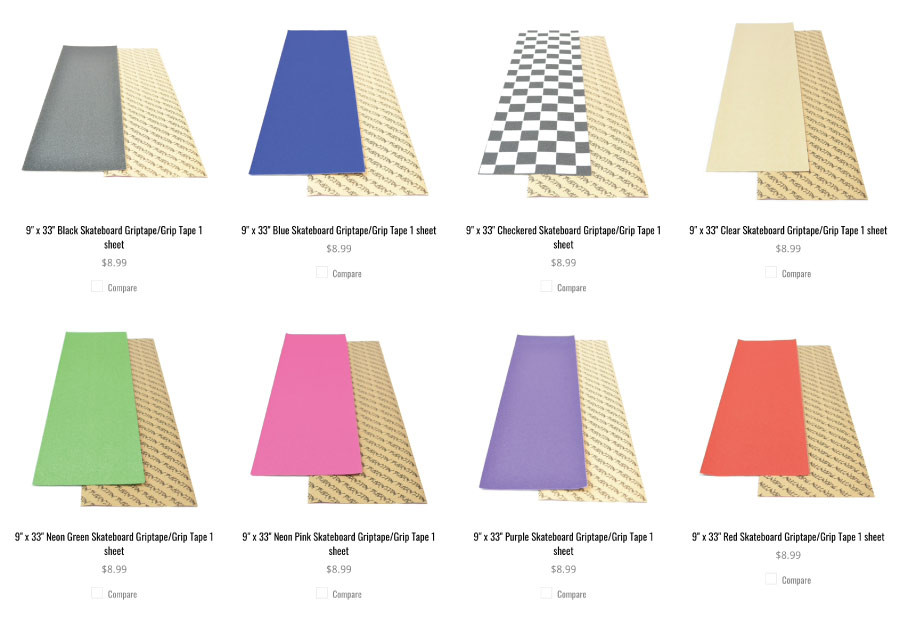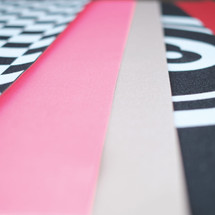Posted by Yocaher Skateboards on Mar 8th 2019
The History and Evolution of Griptape
Skateboarders today have a wealth of griptape options, but it wasn’t always so. From hand-stenciled designs to the multiple available colorways, griptape has come a long way since its earliest forms. Let’s take a closer look at the least-appreciated skate accessory.
Fighting Slip
It’s no secret that skateboards arose from surfing in the 1960s. Just as today, surfers of that era used different methods to keep their feet from slipping on their boards. Wax was a common choice, and it remains popular in surfing to this day. Another option, and one which is also still used, is spray adhesive. Both of these products work to provide tackiness that prevents surfers’ feet from slipping on their boards, but they have their drawbacks for skateboarding.

First, they are messy. Wax melts in high temperatures, which is less of a problem for surfers riding in the ocean than skateboarders on concrete. Making a deck sticky with an adhesive means tracking dirt and grime from the road onto the riding surface, which eventually leads back to slipping.
Second, wax and adhesives both wear away over time. This means constantly having to reapply the product to the board. You wouldn’t be able to just keep layering it forever though, which would mean cleaning the sticky mess off your board before each application.
The Equipment Revolution
As the 1960s turned into the 1970s, skateboarding still had no collective solution to its slippage problem. Of course, slipping off the deck wasn’t quite the issue yet that it would soon become. Skating was still an pastime for surfers at that time. It was all carving and cruising. Wheels were mostly metal or clay, and their bearings barely rolled. The equipment simply had not evolved enough.
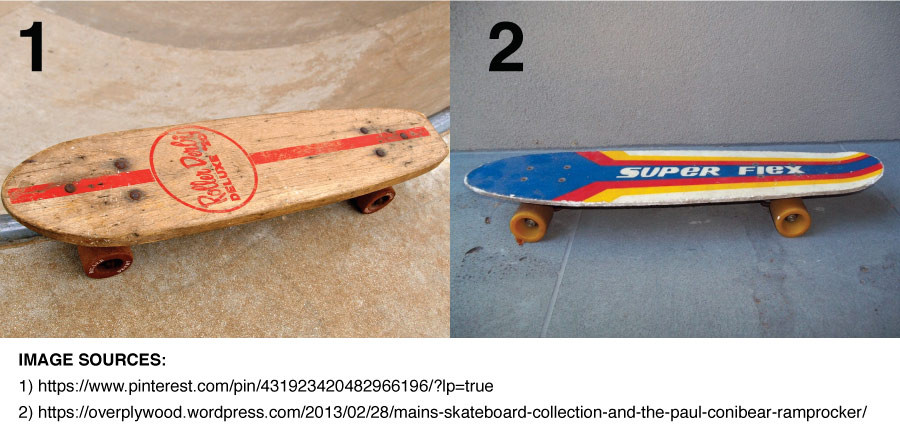
Then everything changed. The years 1972 to 1975 saw the introduction of the first urethane wheels (Cadillac – 1972), precision bearings (in Road Rider urethane wheels – 1974), and purpose-built skateboard trucks (Bennett - 1975). Suddenly riders were able to achieve and sustain much faster speeds. Turns became sharper and quicker, new tricks suddenly became possible, and the need for grip increased exponentially.
The Griptape Solution
No one knows who the first person to think to apply sandpaper to a skateboard deck. If you scan over the pictures of people riding boards before the mid 1970s and those in museums today, you’ll see that the occasional board had griptape. Usually, it would be applied in an offhand way, just strips of sandpaper stuck to the deck, likely with adhesive spray.
It was also around this time that plastic skateboards made their appearance. The surfaces of these boards often had a rough texture or a waffle pattern applied to supply grip. So from pieces of sandpaper to a fully textured surface, the idea of griptape was a logical leap from there. Soon, manufacturers sprang up to fill the new niche.
The Evolution of Backing
The grit in sandpaper is usually silicon carbide, and the same is true for skateboard griptape. Early forms of this product had the grit applied to a paper backing, which had an adhesive applied to the back side of it. If you’ve ever gotten paper wet, you can see the problem that wet backing could cause.
The solution came in the form of plastic backing. Now, grip tape was waterproof. Modern griptape is still made the same way. The plastic backing does not deteriorate, so the grip on a modern skateboard will long outlast the deck itself.
Self-Expression
From the time it first appeared on a skateboard, people have been cutting griptape into strips and shapes and fitting them onto their boards. Applying griptape makes the perfect opportunity to express yourself and to make your board stand out. Skaters in the 1980s took griptape art to extremes.
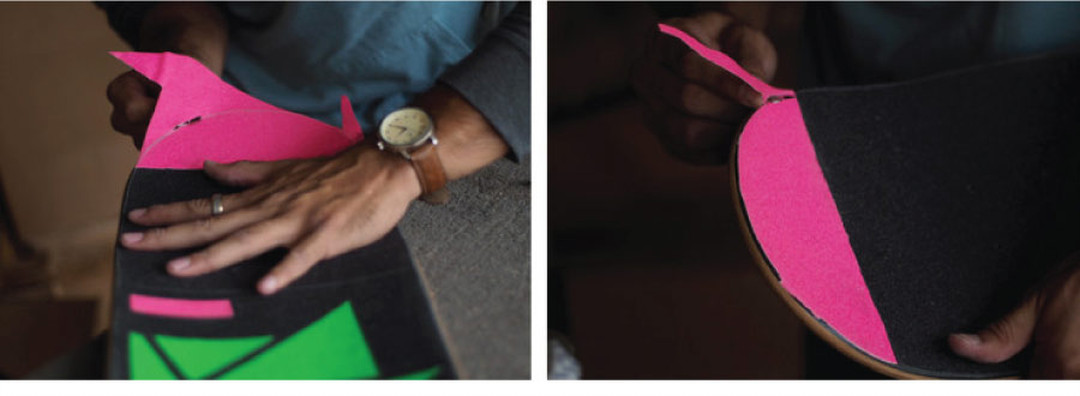
Colored grip tape first hit the market in the 80s, as manufacturers looked to supply skaters’ need to express themselves. Fluorescent colors were a popular item. Skaters would mix and match the colors into creative patterns. Most skate shops of the time sold those brightly colored griptapes from rolls by the foot. Die-cut griptape also hit the market in the 80s, with shapes precut into each sheet roll.
Moving Toward Today
Those outlandish colors and griptape art projects did not outlast the decade. As the 80s gave way to the 90s, skateboarding in general became more homogenized. Simple black griptape has always been a popular choice. The more subdued skaters in the 80s would commonly affix a front section and tail section of black griptape, leaving an empty section in the middle to show off the board maker’s logo.
The early 90s was also the time that the popsicle shape appeared. As both ends of the board were nearly – though not perfectly – identical, skaters needed a way to distinguish the nose from the tail. The typical solution was to slice the sheet of griptape in half, leaving more material to one side, then making a little space between the two pieces when applying it. That way, the rider to look down and find the line to tell nose from tail, rather than flipping the board to look at the graphics.
Modern Griptape
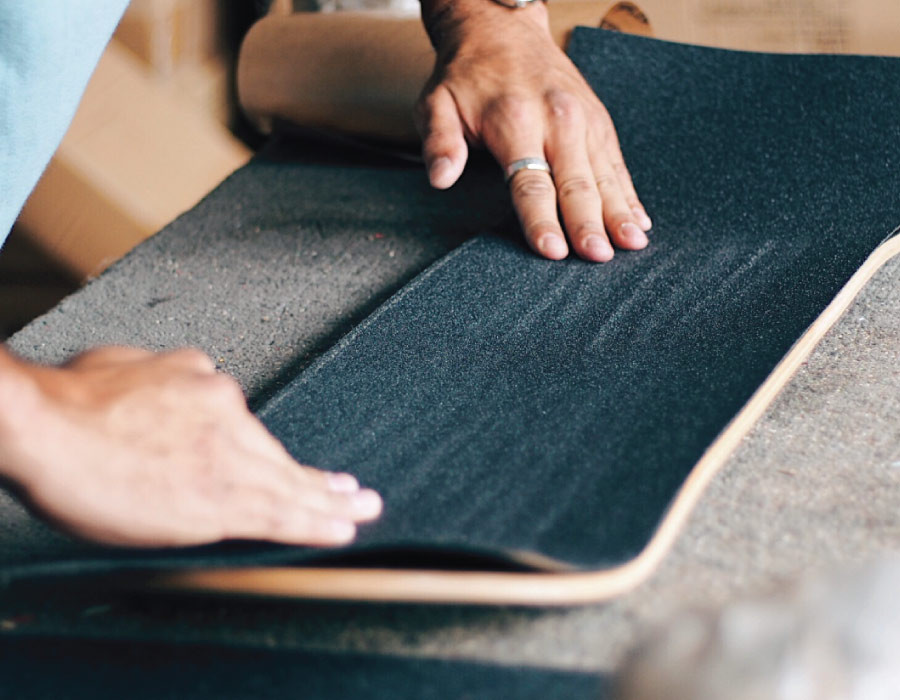
Griptape today is essentially the same product that it was in the early days, but skaters are once again expressing themselves with it. Different colors are increasingly becoming popular. Another decoration method that is coming back is writing, drawing or stenciling griptape. In the modern era, skateboarders can be comfortable doing whatever they desire when they apply their griptape.
Be wary when choosing griptape, though, because its grit varies from one type to another. Too fine of a grit may allow slipping, while too rough of a grit will tear up your shoes faster. Yocaher’s Black Widow griptape has a medium grit – right in the sweet spot. It is available in plain black as well as a variety of vibrant colors, including the always-popular black and white checkerboard pattern.
Your skateboard is an extension of you. Don’t be afraid to express yourself with the griptape you choose to affix to your board, and don’t be nervous. You can always remove your griptape if you don’t like and stick on something else. And whether it looks great or you’re just leaving it until you get your next board, the griptape will do the same thankless-but-dependable job it has always done.
On that note, check out our grip tape offerings. Click HERE (or click the images below)
